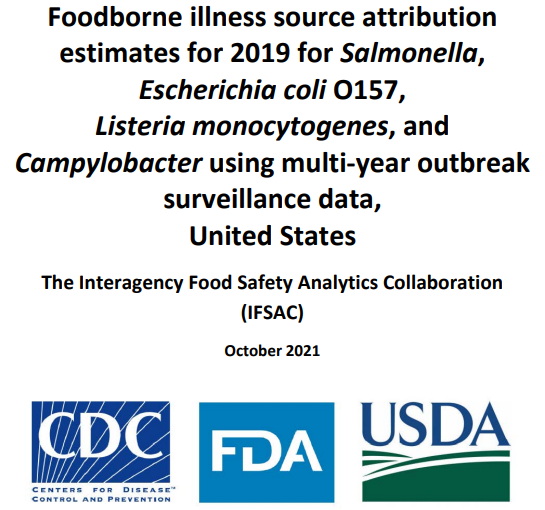The Interagency Food Safety Analytics Collaboration (IFSAC) is a tri-agency group created by the CDC, the FDA, and the USDA-FSIS. Each year in the US, an estimated 9 million people get sick, 56,000 are hospitalized, and 1,300 die of foodborne diseases caused by food pathogens. IFSAC developed a method to estimate the percentages of foodborne illness attributed to food sources using outbreak data from 1998 through the most recent year for four priority pathogens: Salmonella, Escherichia coli O157, Listeria monocytogenes, and Campylobacter. Foods are categorized using a scheme IFSAC created that classifies foods into 17 categories. Salmonella illnesses came from a wide variety of foods. More than 75% of Salmonella illnesses were attributed to seven food categories: Chicken, Fruits, Pork, Seeded Vegetables (such as tomatoes), Other Produce (such as nuts), Turkey, and Eggs. E. coli O157 illnesses were most often linked to Vegetable Row Crops (such as leafy greens) and Beef. Over 75% of illnesses were linked to these two categories. Listeria monocytogenes illnesses were most often linked to Dairy Products and Fruits. More than 75% of illnesses were attributed to these two categories, but the rarity of Listeria monocytogenes outbreaks makes these estimates less reliable than those for other pathogens. Non-Dairy Campylobacter illnesses were most often linked to Chicken. Over 80% of non-Dairy foodborne illnesses were attributed to Chicken, Other Seafood (such as shellfish), and Turkey, with Campylobacter illnesses most often linked to Chicken. @ https://www.cdc.gov/foodsafety/ifsac/pdf/P19-2019-report-TriAgency-508.pdf
Foodborne illness source estimates for 2019 in the United States
No comments

